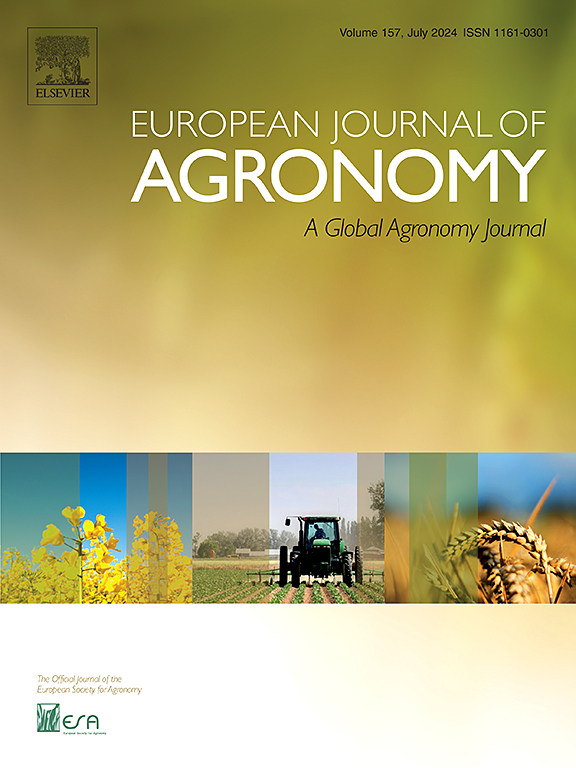经血浆处理的牛粪对草地有适度的肥料作用
IF 5.5
1区 农林科学
Q1 AGRONOMY
引用次数: 0
摘要
有机肥料的等离子体富氮是利用等离子体技术和电力向液态生物基肥料中注入大气氮,使植物有效氮含量增加一倍的过程。最终产品被标记为富氮有机肥(NEO)。本研究调查并比较了2020-2023年挪威两个地区NEO与传统肥料在草生产中的适用性。就不同肥料的氮素效率而言,在单草试验中,在NEO中施用210 kg N ha−1所产生的干物质(DM)和氮素产量分别与在矿物肥中施用149和154 kg N ha−1所获得的产量相当。另外,未处理的牛浆与含210 kg N ha−1的矿物肥组合,DM和N产量分别相当于矿物肥的178和180 kg N ha−1。在草-三叶草混合试验中,NEO和矿肥降低了三叶草的比例,显著影响了总产量。综合所有试验(2021-2022)的结果发现,给予相同的N-min含量,单独的矿物肥,以及未经处理的浆和矿物肥组合,DM和N的产量分别比NEO高~ 19 %和~ 28 %,以及~ 14 %和~ 13.5 %。此外,与未经处理的泥浆相比,NEO的DM和N产量分别提高了~ 9 %和~ 25 %。值得注意的是,NEO的N-min含量几乎是未处理浆的两倍(210 vs 107 kg N ha−1)。尽管如此,一项补充试验(2023年)采用亚硝酸盐含量降低和硝酸盐含量升高的不同NEO变体,获得了比前几年更有希望的结果。尽管如此,在相同的210 kg N ha - 1含量下,DM和N产量比矿肥低~ 9 %和~ 6 %。我们的研究结果表明,尽管与其他施肥处理相比,NEO的相当一部分N没有转化为产量,并且考虑到NEO是一种不断发展的产品,但NEO在最后研究年度的增强性能突出了继续研究和优化的必要性,以充分释放和利用NEO在未来农业中的潜在优势。本文章由计算机程序翻译,如有差异,请以英文原文为准。
Plasma treated cattle slurry with modest fertilizer effect on grass
Plasma-based nitrogen (N) enrichment of organic fertilizers is a process that utilizes plasma technology and electricity to infuse liquid biobased fertilizers with atmospheric N, doubling plant-available N content. The final product is labeled as Nitrogen-Enriched Organic Fertilizer (NEO). This study investigates and compares the applicability of NEO against conventional fertilizers in grass production during 2020–2023 across two regions in Norway. Regarding different fertilizers' N efficacy, in the trials featuring only grasses, applying 210 kg N ha−1 in NEO yielded dry matter (DM) and N yield comparable to those achieved with 149 and 154 kg N ha−1 in mineral fertilizer, respectively. Besides, the untreated cattle slurry and mineral fertilizer combination containing 210 kg N ha−1 resulted in a DM and N yield equivalent to 178 and 180 kg N ha−1 in mineral fertilizer. In the grass-clover mixture trials, NEO and mineral fertilizers reduced the clover proportion, significantly influencing the overall yield. Merging the results from all trials (2021–2022), it was found that given identical N-min content, standalone mineral fertilizer, and the untreated slurry and mineral fertilizer combination resulted in ∼19 % and ∼28 %, and ∼14 % and ∼13.5 % higher DM and N yields than NEO, respectively. Further, NEO provided ∼9 % and ∼25 % higher DM and N yields than untreated slurry. Notably, NEO's N-min content was nearly double that of untreated slurry (210 vs. 107 kg N ha−1). Nonetheless, a supplementary trial (2023) employing different NEO variants with reduced nitrite and elevated nitrate levels returned more promising results than those examined in prior years. Still, ∼9 % and ∼6 % less DM and N yield than mineral fertilizer with identical 210 kg N ha−1 content. Our findings suggest that although a considerable N fraction of NEO did not translate to yields compared to other fertilization treatments, and given that NEO is an evolving product, the NEO's enhanced performance in the final study year highlights the necessity for continued research and optimization to fully unlock and utilize the potential advantages of NEO in future agriculture.
求助全文
通过发布文献求助,成功后即可免费获取论文全文。
去求助
来源期刊

European Journal of Agronomy
农林科学-农艺学
CiteScore
8.30
自引率
7.70%
发文量
187
审稿时长
4.5 months
期刊介绍:
The European Journal of Agronomy, the official journal of the European Society for Agronomy, publishes original research papers reporting experimental and theoretical contributions to field-based agronomy and crop science. The journal will consider research at the field level for agricultural, horticultural and tree crops, that uses comprehensive and explanatory approaches. The EJA covers the following topics:
crop physiology
crop production and management including irrigation, fertilization and soil management
agroclimatology and modelling
plant-soil relationships
crop quality and post-harvest physiology
farming and cropping systems
agroecosystems and the environment
crop-weed interactions and management
organic farming
horticultural crops
papers from the European Society for Agronomy bi-annual meetings
In determining the suitability of submitted articles for publication, particular scrutiny is placed on the degree of novelty and significance of the research and the extent to which it adds to existing knowledge in agronomy.
 求助内容:
求助内容: 应助结果提醒方式:
应助结果提醒方式:


